‘This is sacred ground’: Austinites and researchers seek to restore Mexican American cemeteries in Montopolis
Wednesday, July 7, 2021 by
Marisa Charpentier, KUT Sandwiched between private properties in southeastern Travis County sits a little-known cemetery off Hoeke Lane, just west of U.S. Highway 183. From the outside, there’s nothing that indicates the site is the final resting place for a number of Mexican and Mexican American residents who died decades ago.
It’s a wilderness. The headstones, many of which date back to the 1940s, are easy to miss. The weeds are overgrown, and trees and shrubs cover much of the 4.5-acre plot.
The cemetery has been called a couple of different names over the years – the Montopolis Cemetery and San José II. But no sign will tell you that. In fact, there’s scarce information available about the cemetery’s history at all.
But members of the community and a team of researchers are trying to change that. They want to trace back its history and ensure the cemetery, along with its sister site in nearby Montopolis, is preserved.
Diana Hernandez is the lead researcher for (Re)claiming Memories, a research group out of UT Austin that seeks to restore and preserve missing histories in communities of color. She and her team have been collecting death certificates and reaching out to descendants of those buried at the cemeteries to help piece together their history.
“Once we start to research the people that are buried here and start to find archival documentation for each person, we start to see the community come to life through the cemetery,” she said.
The History
To understand San José II, Hernandez says, we have to start about 2 miles north at San José I. This historic Mexican and Mexican American cemetery was built around 1919. It sits between two churches off Montopolis Drive, though neither of them own it. The site is believed to be unclaimed, or orphaned, meaning no one is responsible for its upkeep in any official capacity. But neighbors and community members have taken care of it as best they can over the years, mowing the lawn, pulling weeds and cleaning off gravestones.
A metal archway standing at the entrance reads “San Jose Cementerio.” The cemetery was founded by a mutual aid society called the Union Fraternal Mexicana, and it served the migrant sharecropping community. This was during segregation.
“Mexicans weren’t necessarily allowed to be buried in white cemeteries,” Hernandez said. “In some cases I’ve seen where there’s a white cemetery, and then right next to it is the Mexican section or the Black section. … In this case, it was just a completely different cemetery.”
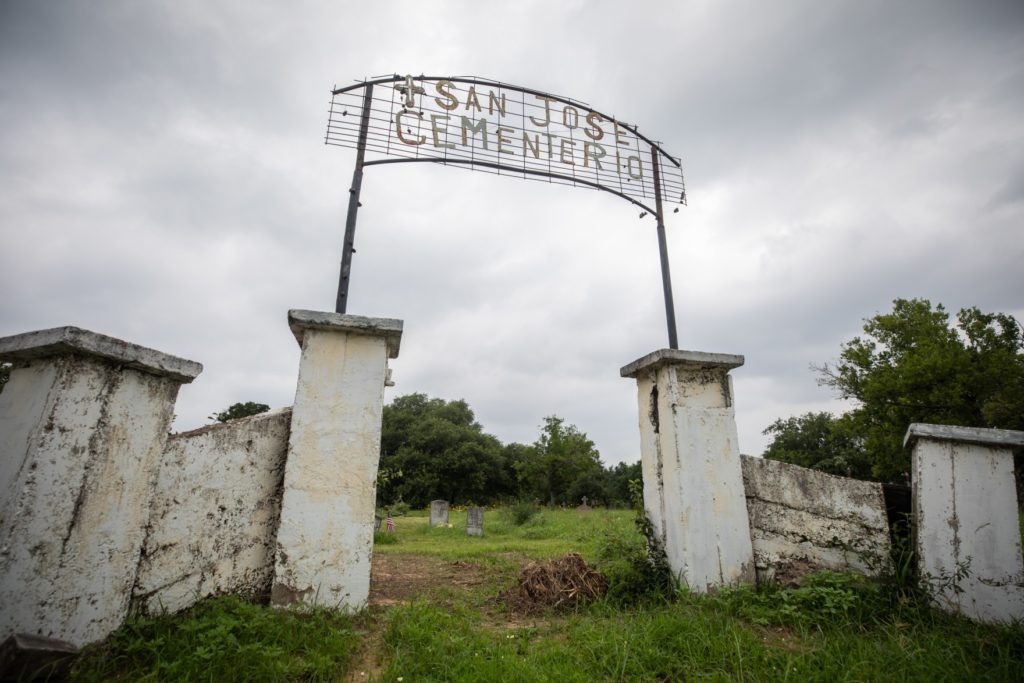
An arch stands at the entrance of Cementerio San José. Michael Minasi/KUT
Land for the cemetery was donated by an African American woman named Lizzie Henry.
“She just had it in her heart to give the land to help establish the Mexican cemetery,” Hernandez said. “To me, that was very amazing because it shows the history of solidarity between the Black and brown community, which is something that isn’t really highlighted.”
When Cementerio San José started to get full, the second one was created in 1949 in Del Valle. Over the years, the cemeteries changed hands. The original San José hasn’t had a known owner for several decades. San José II has an owner, but she’s believed to be in poor health and unable to maintain it, according to Hernandez. KUT reached out to the owner, but did not hear back.
Based on their research so far, Hernandez and her team estimate San José I and II have more than 350 burials combined. But understanding how many burials are at each individual site is a challenge. That’s partly because on death certificates, the name Montopolis Cemetery was often used interchangeably for San José I and II. And not every burial has a gravestone.
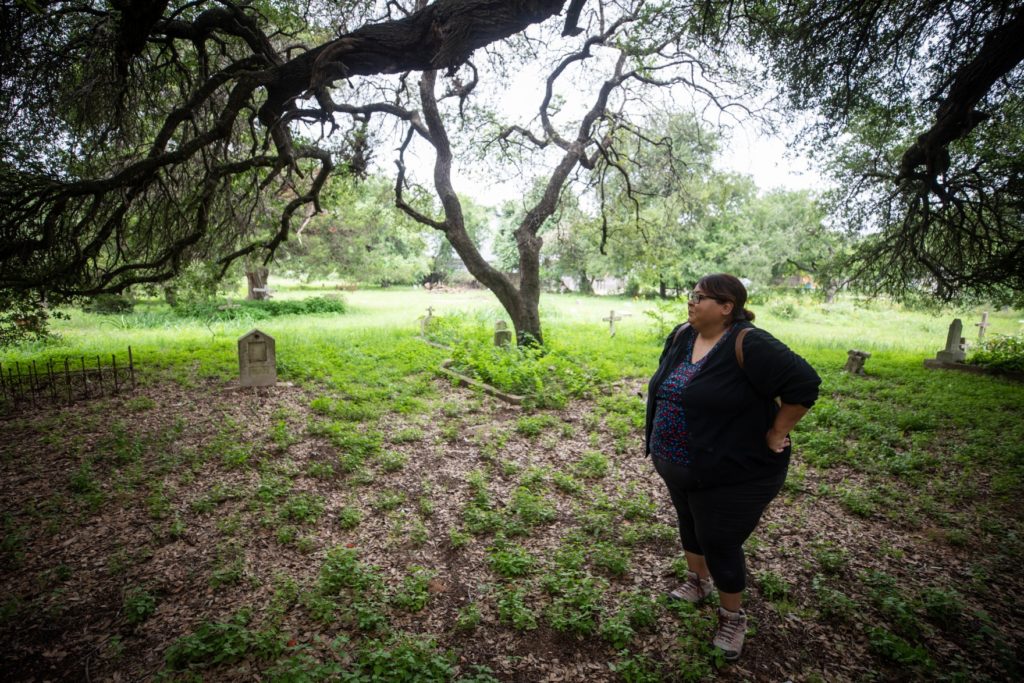
Diana Hernandez is the lead researcher for (Re)claiming Memories at UT Austin. Michael Minasi/KUT
Many people buried at the cemeteries died during concurrent epidemics, like influenza, tuberculosis and pneumonia.
“They were getting so many bodies that they were burying people in layers on top of each other, and they stopped documenting who all was getting buried,” she said. “Because there’s no documentation for the number of layers for the people that were being buried in these mass graves, we’re just never going to know. There’s going to be layers of people that we’re never going to be able to identify.”
Hernandez began researching the San José cemeteries at the end of 2019, just before the area was hit with another outbreak of a deadly disease: Covid-19. And again, this predominantly Latino neighborhood was hit harder than others.
“These histories repeat themselves,” Hernandez said. “I think that’s one of the reasons why this work is important, because it kind of sheds light on these pasts that weren’t acknowledged the way they should have been. We can use this knowledge to improve our present.”
The Descendants
Frank Monreal remembers the days when Montopolis Drive was just a dirt road. He and the other neighborhood kids, some 50 years ago, would play on the giant oak tree that stands in the middle of Cementerio San José. Instead of bicycles, he and his friends had horses.
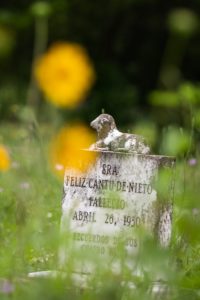
“Everybody rode horses back then,” he said one day while at San José I. “We used to come out here, and they were our lawn mowers. They let them eat the grass and keep the grass low here.”
Monreal has relatives buried at San José I and II. From an early age, he understood death was a natural part of life. An altar boy at Dolores Catholic Church, just down the road from the cemetery, he often helped out with funerals. He remembers one burial happening at Cementerio San José when he was a kid. But it’s been a long time since anyone was buried there, he says. Most gravesites appear to date back to the 1930s, 1940s and 1950s.
There were more gravestones back then, he says, but some have weathered or broken over time. He used to walk through the cemetery on his way to school in the 1960s and 1970s. He’d often see people putting flowers on graves, something he doesn’t see much anymore. Now, many relatives have died or left.
“That’s inevitable, you know, because generations change,” he said. “People move away.”
Preserving the cemetery, though, is important, he says, especially as gentrification has altered the landscape of Montopolis over the years.
“(The cemetery) is sacred ground to us, from our ancestors,” he said. “I don’t want to see it gone.”
Micaela Johnson, a 19-year-old artist and activist, can trace a lot of her family tree back to Cementerio San José. She’s part of the Limón family, one of Austin’s founding families whose descendants now number upward of 3,500.
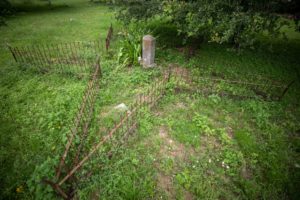
Someone is buried in each point of this star-shaped grave at San José II cemetery. They were co-workers killed in a fire at an ice plant, said (Re)claiming Memories researcher Diana Hernandez. Michael Minasi/KUT
Many of her family members grew up and had businesses in Montopolis, like the Limón Bakery. She said her grandparents probably have connections to at least a quarter of the people buried at San José.
In her family, passing down stories from generation to generation is a common tradition. She remembers hearing stories about Aurora, her grandfather’s sister, who died in 1940 of pneumonia when she was 11 months old. She was buried at Cementerio San José, and her gravestone was decorated with marbles. But Johnson hasn’t been able to locate it.
She also remembers stories of Concepcion Treviño Garcia, her great-great-grandmother who died in 1939 from tuberculosis and was buried at San José. She left behind her husband and five young daughters.
“She was one of the strongest women that I have ever heard my family talk about,” Johnson said. “She was very driven and very loving.”
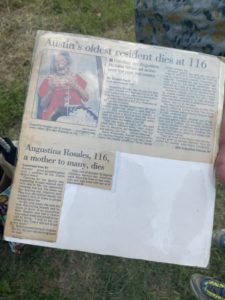
Delfina Moncada Romo holds up an Austin American-Statesman article about her grandmother, Augustina Rosales, who died in 1994 at the age of 116. She was buried in San José I. Marisa Charpentier/KUT
Treviño Garcia’s grandchildren still visit the cemetery on Mother’s Day and leave flowers, Johnson said. Her family’s connection to the cemetery has inspired her to get involved with (Re)claiming Memories and help ensure the San José cemeteries are well kept.
“It’s not just a place where people are buried,” she said. “It’s the life and the heart of a lot of our ancestry.”
One of the more recent headstones at Cementerio San José belongs to Augustina Rosales, who was at one time believed to be Austin’s oldest living resident. She died in 1994 at age 116. Near the back of the cemetery, she’s buried next to her husband Marcos, who died in 1951.
Rosales had 13 children, and raised several others who were relatives or orphaned as if they were her own. She liked to drink brandy, dance to conjunto music and cook for her family, according to an Austin American-Statesman article about her death. Rosa Moncada, Rosales’ great-granddaughter, says “she was awesome.”
“I remember when she was ready to cook dinner for us. She would go out to the backyard, grab one of the chickens, pop its neck and cut the head off and pluck it, and we were having chicken that night,” Moncada said with a laugh.
Maintaining the Cemeteries
Moncada has several other relatives buried at San José, including grandparents and two older sisters who were born premature and died. Growing up in East Austin, Moncada would go with her mother and siblings to visit the cemetery. But they went less frequently over time, in part because the grass was often so high they couldn’t easily walk through it.
When they heard about the work Hernandez and her team are doing to help maintain the cemetery, Moncada and her sister Juanita Moncada Bayer started visiting again. And now they’re trying to keep it maintained, bringing relatives together to mow the lawn and clear out dead tree branches.
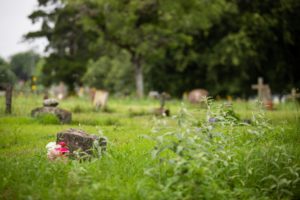
Cementerio San José doesn’t have a known owner. It relies on the community to keep it maintained. Michael Minasi/KUT
But maintaining the cemetery consistently isn’t an easy task. San José I is 2.5 acres.
“We thought, well, let’s do what we can,” Bayer said. “But unfortunately, our mind tells us we can do it. But our bodies – like, that’s hard work.”
(Re)claiming Memories and members of the community hosted a cleanup for San José earlier this year and hope to host more. They have been reaching out to city and county leaders, asking them to allocate more resources to the cemeteries’ maintenance.
The more challenging endeavor will be cleaning up San José II. The site is difficult to access, making it hard for people to visit and maintain it.
Monreal remembers going to San José II as a kid to visit his grandfather’s grave with his dad. Back then, San José II had a proper entrance and was easier to get to.
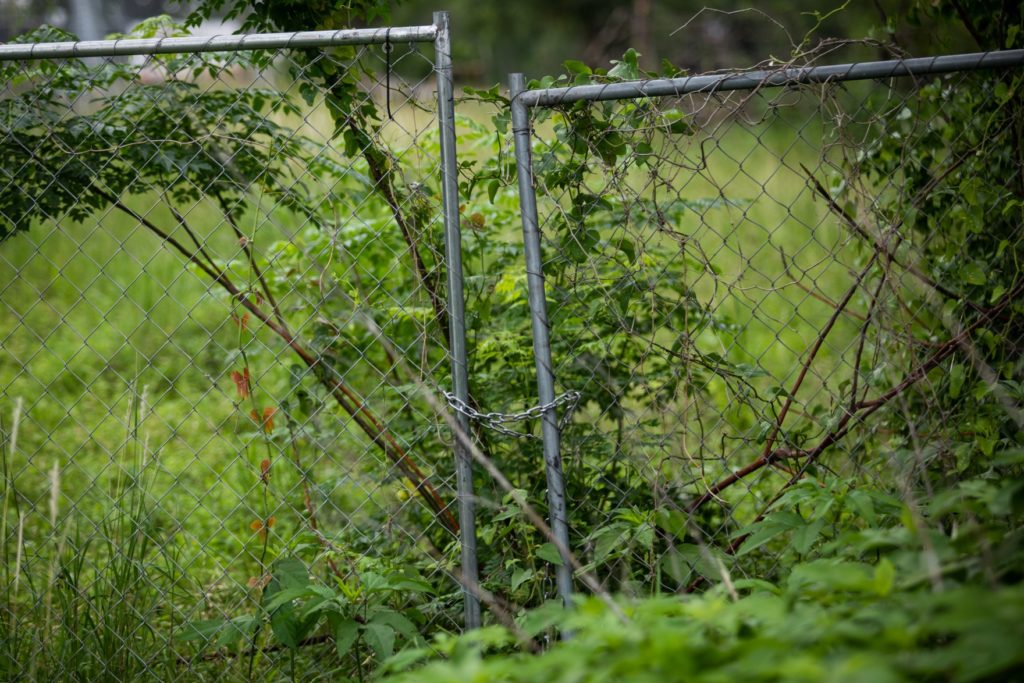
A gate now blocks the path that leads to San José II. Michael Minasi/KUT
Now, a locked chain-link fence blocks the main path that leads to the cemetery. Several sources told KUT the fence was put up by the property owner next door, perhaps to keep people from trespassing. KUT reached out to the law office that owns the property and was told it didn’t have anything to do with the gate. Hernandez and the research group are trying to get to the bottom of the issue and hope to create a proper entrance, so descendants can visit.
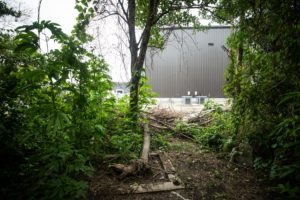
Warehouses are under construction on one side of San José II. Michael Minasi/KUT
The area has long had problems with people dumping trash and gravel. A mound of dirt and debris now presses against fencing on one side of the cemetery.
And warehouses are being built on the southeastern side. This worries Hernandez because the cemetery hasn’t been surveyed; some burials could be outside the perimeter and could be disturbed. Community members have expressed concern that debris from construction is impacting the cemetery.
When KUT reached out to the construction manager for the company that’s developing the site, he was surprised to learn there was a cemetery next door. (“That is a jungle,” Brent Ramirez said.) He later went out to visit the site and told KUT he believes the debris impacting the cemetery wasn’t from the construction project, but said he was happy to work with (Re)claiming Memories to help remove some of it.
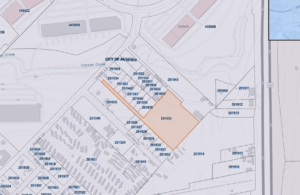
A Travis Central Appraisal District map shows warehouses and parking lots that have been built near the San José II cemetery in southeastern Travis County. San José II is marked in orange.
The cemetery itself is zoned for warehouse and limited office use, which some are concerned could make it vulnerable to development. (Re)claiming Memories is working with City Council Member Vanessa Fuentes to get the proper zoning for it and a historical designation. Fuentes toured the cemetery earlier this year.
“It’s sad to see because it looks as if it’s been neglected and dismissed, especially with the development that’s right next to it,” she said. “Those are families and families’ history and legacies and relatives that are buried there. Those are stories that need to be told.”
‘This Is About Texas History’
Currently, pink marking flags stick up in various spots within the shrubbery of San José II. That’s the work of Joaquin Rodriguez, an Austin resident who has been going out to the cemetery to remove litter and clean off and mark gravestones that have been covered up over time.
He first learned about the cemetery late last year while researching his ancestry. Rodriguez, who was adopted, had taken a DNA test and learned he had relatives buried at cemeteries throughout Austin, including San José I and II. After seeing how neglected San José II was, he decided to take matters into his own hands. But his motivation to help restore the site extends beyond just his familial link.
“That whole area is rich in pre-Austin history,” Rodriguez said. “I was unable to just isolate, ‘OK, this is just about my family.’ This is about Texas history.”
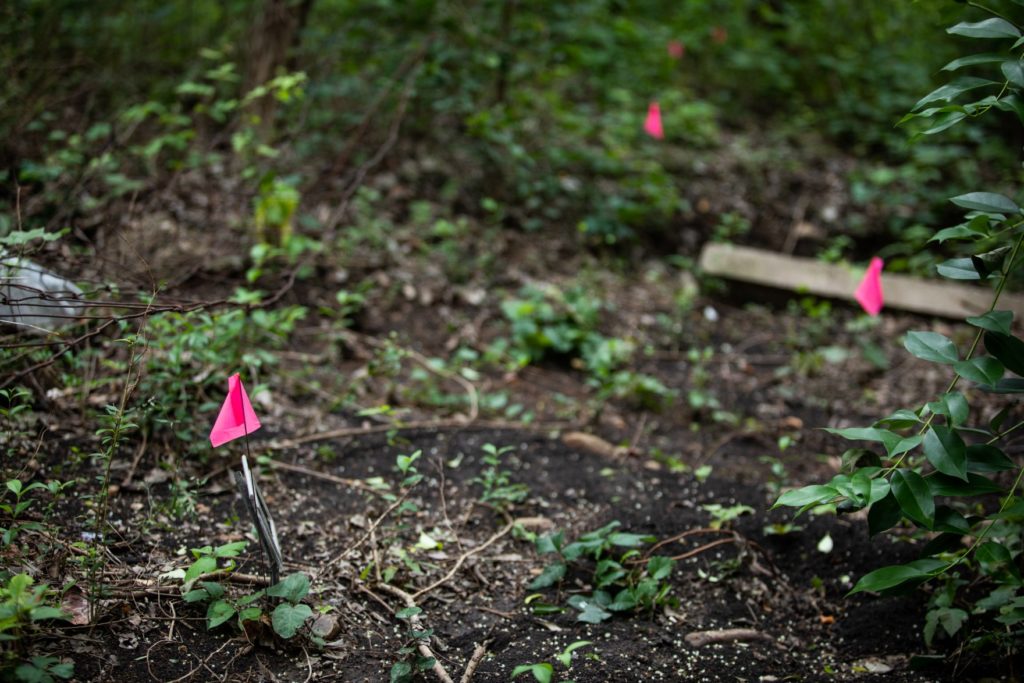
Austin resident Joaquin Rodriguez has been placing flags at gravestones he’s uncovered at San José II. Michael Minasi/KUT
The (Re)claiming Memories team wants to eventually create a digital map or database where people can upload information about the people buried at the cemeteries. Hernandez hopes this crowdsourced online resource will help bring the stories of the deceased together and shed light on the history of the Mexican and Mexican American community in Montopolis.
The team is also putting together an exhibit on the cemeteries for the Mexic-Arte Museum in September. Johnson plans to perform a poem called “We Are Lost History” and sell shirts she designed, the proceeds from which will support the cemeteries’ upkeep.
Johnson said she recognizes that Austinites who are not directly connected to the cemeteries may not see a reason to care about them, but she thinks they should.
“They might just see it as another gravesite or another old ancient Mexican burial ground, and they might (think) it doesn’t matter because it’s not a part of them,” Johnson said. “But it is a part of them. It’s a part of the history of Austin.”
And as development continues to alter the look and population of the Montopolis neighborhood, she says, it’s urgent to keep conversations about the cemeteries going.
“If we’re not actively trying to be like, hey, this matters,” she said, “it’ll get washed away.”
Update: A previous version of this story included information on when Montopolis was founded. It was removed because historians have differing ideas about when it started and its original geographic reach. This story was produced as part of the Austin Monitor’s reporting partnership with KUT.
The Austin Monitor’s work is made possible by donations from the community. Though our reporting covers donors from time to time, we are careful to keep business and editorial efforts separate while maintaining transparency. A complete list of donors is available here, and our code of ethics is explained here.
You're a community leader
And we’re honored you look to us for serious, in-depth news. You know a strong community needs local and dedicated watchdog reporting. We’re here for you and that won’t change. Now will you take the powerful next step and support our nonprofit news organization?


















